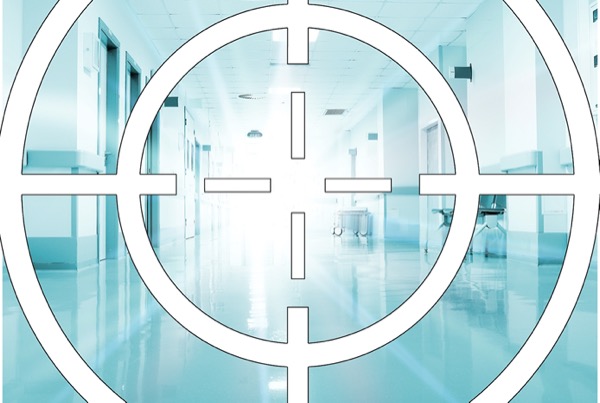One year ago this month, I walked into the surgeon’s lounge after an early morning case. As I sat down to dictate, I heard a colleague remark, “There’s an active shooter in the hospital.”
My throat tightened and my voice squeaked as I asked, “Are you kidding?”
Fellow surgeons, including some of my residents, looked up from their computers but appeared unphased. Whether this calm exterior was secondary to years of training during which we learn to maintain equanimity during stressful moments or simply because they truly were not alarmed, I can’t say. Meanwhile, I transformed from a reasonably confident adult, capable of making multiple life and death decisions throughout a typical workday, to a trapped, frightened child – breath short, heart racing, eyes darting towards the door, needing desperately to escape.
“At least there’s a trauma surgeon in the room,” someone quipped as they looked my way and chuckled. At that point, my internal world again shifted and my adult mind realized, “Wow. These folks really don’t get it. I need to GO.”
I turned to my residents, told them I would be back, and left the room. I walked down a long corridor, frantically searching for an exit sign; we had recently moved into a new hospital tower and, in my panic, I became completely disoriented. An announcement rang out over head: “Shots fired! This is not a drill!” and I was forced to accept that my fantasy of busting out through a steel door into the chilly winter day was not going to happen. Instead, I walked past an empty bathroom and scurried inside, locking the heavy door behind me. I set the plastic garbage can between the door and the corner, where I sunk to the floor, wrapped my arms around my knees and wept.
The situation felt eerily inevitable. Twenty-five years ago, my father had been shot to death as he stood up from his table at a restaurant in Cairo, Egypt. I’ve spent the last two and half decades painfully aware that none of us are immune to random acts of violence. And my job – I practice as both a trauma surgeon and as a hospice and palliative care physician – confirms this on an almost a daily basis.
Hiding in the small, dark room, I called my boyfriend and cried quietly into the phone, but the fear of being discovered led me to cut the conversation short. I switched my phone to silent as a message appeared on my screen: “SECURITY ALERT. Active shooter on 9A. Please secure your areas and follow appropriate precautions.” I wondered what exactly constituted appropriate precautions while I texted my residents and coworkers, checking to see if they were okay. I was particularly anxious to hear back from those that I knew were rounding on the 9th floor, where the majority of our trauma patients were admitted, most lying helplessly in their beds.
In between texts, I thought mostly about my dead dad, one year older than I was at the time, lying on a restaurant floor, alone, choking as his lungs filled with blood. Was he scared? Was he in pain? Did he know he was dying? I almost never allow myself to perseverate on the details of my father’s last minutes, but having read his autopsy report and having trained as a trauma surgeon, I know more than enough to accurately imagine what he experienced as he died Alone in the bathroom, crouching next to the garbage can, I was acutely aware of everything I was thinking and feeling; yet I also felt like an innocent bystander, witnessing my present situation and my past trauma collide in my head, leading my mind to places it had no business visiting and then abandoning me there. I was stranded with my thoughts, feeling utterly helpless, but somehow also secure in the knowledge that I was the only one in charge of my own rescue.
Despite visions of my dying dad and what I imagined to be bodies strewn along the 9th floor hallway, my training did eventually kick in. I was painfully aware that I had abandoned my residents in an attempt to secure my own safety. “Are you guys okay?” I texted again. “Please stay safe.”
Another ten minutes passed and a voice overhead announced, “Active shooter All Clear.” I was skeptical and terrified as I turned on the light in the bathroom, rubbed at my eyes and emerged into a fairly normal-appearing world. Multiple employees walked by with without even glancing in my direction. The operating room control desk buzzed with activity. My residents were animated, but appeared unphased, despite my asking them multiple times if they were okay. We headed up to the wards to continue rounding on our patients.
Many patients knew nothing about the incident; apparently the overhead announcements were not audible in their rooms. Others were too sick to care. Some staff shared stories of hiding in locked medication rooms, fearing for their lives, while others shared stories of securing doors that failed to lock with sheets tied around door handles. I also encountered an odd mix of arrogance and ignorance, particularly amongst those tasked with caring for our sickest patients, as if they felt they would be somehow immune to the violence. Or perhaps they felt called to care for their patients and were simply braver than I could ever be. The variety of responses was disturbing, particularly at a time when a well-coordinated effort might ensure both provider and patient safety.
As the day wore on, multiple stories emerged about what really happened: there was no gun, there was a man with a gun but no shots were fired, there was a man with a gun and a bogus threat called into the hospital at the exact same time. The day ended with a short note in my inbox, thanking me for my resilience.
One year later, I am still left feeling anxious, angry and ashamed. I am anxious because I still don’t know exactly what triggered this event. And despite a recent active shooter simulation, I’m not convinced that I will feel any safer the next time this occurs.
I am angry because I am left wondering: Who is tasked with my well-being? Who, in the setting of recent security cuts, is in charge of protecting me? And who – besides me – is fretting over the fact that there is a small part of me still stuck on the bathroom floor? Like most surgeons, I am remarkably resilient; I show up to work and maintain a relatively positive attitude despite difficult operations, sometimes disastrous complications and occasional devastating deaths. At what point, however, did the expectation of my resilience begin to extend to threats upon my personal safety? Why is it assumed that I, and so many others, will simply “bounce back” after experiencing such a threat?
And I am ashamed because I so quickly left my residents in an attempt to flee to safety, and so willingly abandoned my patients in an effort to save myself. I watched, passively, as the past dictated my response to the present. As someone who views herself as dedicated to both her team and to her patients, I exposed myself as both a flawed human being and as a coward.
Over the years, my father’s murder has become a prism through which I view the world. Through this prism, I found my purpose: as a trauma surgeon working to save lives and as a hospice and palliative medicine physician striving to ease suffering. It is through this prism that I’ve attempted to process my anxiety, my anger and my shame, all of which I know were inevitably amplified because of my history. It is through this prism that I continue to connect with my colleagues, my patients and their families. And it is through this prism that I’m still searching for those exit signs, just in case.
 Back to Blog Homepage
Back to Blog Homepage
